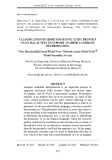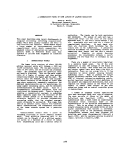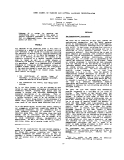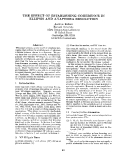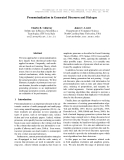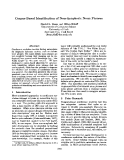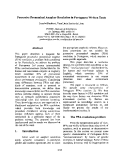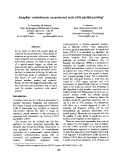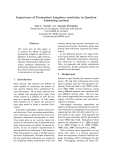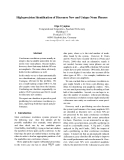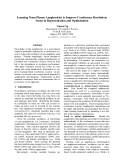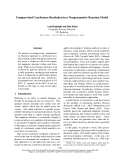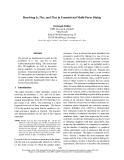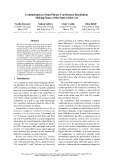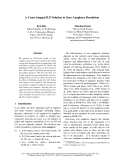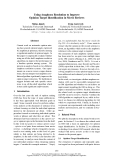
Anaphor resolution
-
The results of the F-measure showed the detection of clitic nya as a separate word achieved a perfect 100% result. In comparison, the clitic nya as a pleonastic achieved 88%, clitic nya referring to humans achieved 94%, and clitic nya referring to non-humans achieved 63%.
 20p
20p  spiritedaway36
spiritedaway36
 28-11-2021
28-11-2021
 15
15
 1
1
 Download
Download
-
Most existing anaphora resolution algorithms are designed to account only for anaphors with NP-antecedents. This paper describes an algorithm for the resolution of discourse deictic anaphors, which constitute a large percentage of anaphors in spoken dialogues. The success of the resolution is dependent on the classification of all pronouns and demonstratives into individual, discourse deictic and vague anaphora. Finally, the empirical results of the application of the algorithm to a corpus of spoken dialogues are presented. spoken language cannot succeed without taking this into account.
 8p
8p  bunthai_1
bunthai_1
 06-05-2013
06-05-2013
 43
43
 3
3
 Download
Download
-
This paper describes some r e c e n t d e v e l o p m e n t s i n language processing involving computational models which more closely resemble the brain in both structure and function. These models employ a large number of interconnected parallel computational units which communicate via weighted levels of excitation and inhibition. A specific model is described which uses this approach to process some fragments of connected discourse.
 6p
6p  bungio_1
bungio_1
 03-05-2013
03-05-2013
 44
44
 1
1
 Download
Download
-
This description c a n be u s e d t o guide semantic and discourse level structure recovery processes such as interpretation, anaphoric resolution, focus tracking, given/new distinctions, ellipsis resolution, etc. in a manner that is independent of the lexical and conceptual content of the utterance. There are several advantages to factoring out such knowledge.
 4p
4p  bungio_1
bungio_1
 03-05-2013
03-05-2013
 35
35
 1
1
 Download
Download
-
This paper presents a new model of anaphoric processing that utilizes the establishment of coherence relations between clauses in a discourse. We survey data that comprises a currently stalemated argument over whether VP-ellipsis is an inherently syntactic or inherently semantic phenomenon, and show that the data can be handled within a uniform discourse processing architecture. This architecture, which revises the dichotomy between ellipsis vs.
 8p
8p  bunmoc_1
bunmoc_1
 20-04-2013
20-04-2013
 29
29
 3
3
 Download
Download
-
Previous approaches to pronominalization have largely been theoretical rather than applied in nature. Frequently, such methods are based on Centering Theory, which deals with the resolution of anaphoric pronouns. But it is not clear that complex theoretical mechanisms, while having satisfying explanatory power, are necessary for the actual generation of pronouns. We first illustrate examples of pronouns from various domains, describe a simple method for generating pronouns in an implemented multi-page generation system, and present an evaluation of its performance. ...
 8p
8p  bunmoc_1
bunmoc_1
 20-04-2013
20-04-2013
 40
40
 1
1
 Download
Download
-
Coreference resolution involves finding antecedents for anaphoric discourse entities, such as definite noun phrases. But many definite noun phrases are not anaphoric because their meaning can be understood from general world knowledge (e.g., "the White House" or "the news media"). We have developed a corpus-based algorithm for automatically identifying definite noun phrases that are non-anaphoric, which has the potential to improve the efficiency and accuracy of coreference resolution systems.
 8p
8p  bunrieu_1
bunrieu_1
 18-04-2013
18-04-2013
 40
40
 2
2
 Download
Download
-
This paper describes a proposal for Portuguese possessive pronominal anaphor (PPA) resolution, a problem little considered so far. Particularly, we address the problem of Portuguese 3rd person intrasentential PPAs seu/sua/seus/suas (his/her/their/its, for human and non-human subjects in English), which constitute 30% of pronominal occurrences in our corpus (Brazilian laws about environment protection).
 5p
5p  bunrieu_1
bunrieu_1
 18-04-2013
18-04-2013
 43
43
 3
3
 Download
Download
-
In this paper we deal with several kinds of anaphora in unrestricted texts. These kinds of anaphora are pronominal references, surfacecount anaphora and one-anaphora. In order to solve these anaphors we work on the output of a part-of-speech tagger, on which we automatically apply a partial parsing from the formalism: Slot Unification Grammar, which has been implemented in Prolog. We only use the following kinds of information: lexical (the lemma of each word), morphologic (person, number, gender) and syntactic. ...
 7p
7p  bunrieu_1
bunrieu_1
 18-04-2013
18-04-2013
 47
47
 3
3
 Download
Download
-
The main aim of this paper is to analyse the e ects of applying pronominal anaphora resolution to Question Answering QA systems. For this task a complete QA system has been implemented. System evaluation measures performance improvements obtained when information that is referenced anaphorically in documents is not ignored.
 8p
8p  bunrieu_1
bunrieu_1
 18-04-2013
18-04-2013
 33
33
 1
1
 Download
Download
-
Coreference resolution systems usually attempt to find a suitable antecedent for (almost) every noun phrase. Recent studies, however, show that many definite NPs are not anaphoric. The same claim, obviously, holds for the indefinites as well. In this study we try to learn automatically and two classifications, , relevant for this problem. We use a small training corpus (MUC-7), but also acquire some data from the Internet. Combining our classifiers sequentially, we achieve 88.9% precision and 84.6% recall for discourse new entities. ...
 7p
7p  bunbo_1
bunbo_1
 17-04-2013
17-04-2013
 36
36
 2
2
 Download
Download
-
Knowledge of the anaphoricity of a noun phrase might be profitably exploited by a coreference system to bypass the resolution of non-anaphoric noun phrases. Perhaps surprisingly, recent attempts to incorporate automatically acquired anaphoricity information into coreference systems, however, have led to the degradation in resolution performance. This paper examines several key issues in computing and using anaphoricity information to improve learning-based coreference systems. In particular, we present a new corpus-based approach to anaphoricity determination.
 8p
8p  bunbo_1
bunbo_1
 17-04-2013
17-04-2013
 43
43
 2
2
 Download
Download
-
We present an unsupervised, nonparametric Bayesian approach to coreference resolution which models both global entity identity across a corpus as well as the sequential anaphoric structure within each document. While most existing coreference work is driven by pairwise decisions, our model is fully generative, producing each mention from a combination of global entity properties and local attentional state. Despite being unsupervised, our system achieves a 70.3 MUC F1 measure on the MUC-6 test set, broadly in the range of some recent supervised results. ...
 8p
8p  hongvang_1
hongvang_1
 16-04-2013
16-04-2013
 47
47
 2
2
 Download
Download
-
We present an implemented system for the resolution of it, this, and that in transcribed multi-party dialog. The system handles NP-anaphoric as well as discoursedeictic anaphors, i.e. pronouns with VP antecedents. Selectional preferences for NP or VP antecedents are determined on the basis of corpus counts. Our results show that the system performs significantly better than a recency-based baseline.
 8p
8p  hongvang_1
hongvang_1
 16-04-2013
16-04-2013
 51
51
 1
1
 Download
Download
-
We aim to shed light on the state-of-the-art in NP coreference resolution by teasing apart the differences in the MUC and ACE task definitions, the assumptions made in evaluation methodologies, and inherent differences in text corpora. First, we examine three subproblems that play a role in coreference resolution: named entity recognition, anaphoricity determination, and coreference element detection.
 9p
9p  hongphan_1
hongphan_1
 14-04-2013
14-04-2013
 47
47
 2
2
 Download
Download
-
We present an ILP-based model of zero anaphora detection and resolution that builds on the joint determination of anaphoricity and coreference model proposed by Denis and Baldridge (2007), but revises it and extends it into a three-way ILP problem also incorporating subject detection. We show that this new model outperforms several baselines and competing models, as well as a direct translation of the Denis / Baldridge model, for both Italian and Japanese zero anaphora.
 10p
10p  hongdo_1
hongdo_1
 12-04-2013
12-04-2013
 33
33
 2
2
 Download
Download
-
Current work on automatic opinion mining has ignored opinion targets expressed by anaphorical pronouns, thereby missing a significant number of opinion targets. In this paper we empirically evaluate whether using an off-the-shelf anaphora resolution algorithm can improve the performance of a baseline opinion mining system. We present an analysis based on two different anaphora resolution systems.
 6p
6p  hongdo_1
hongdo_1
 12-04-2013
12-04-2013
 64
64
 3
3
 Download
Download
CHỦ ĐỀ BẠN MUỐN TÌM









